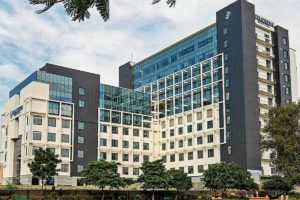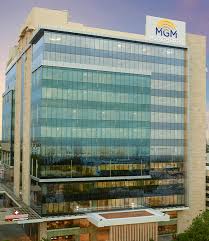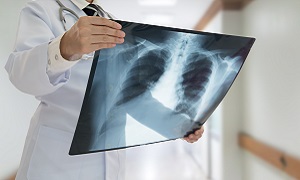Best Doctors in India for Thymectomy
Best Hospitals in India for Thymectomy
Lilavati Hospital & Research Centre, Mumbai
- City: Mumbai, India
Hospital Highlights:
- Lilavati Hospital & Research Centre is India’s premier multi-speciality tertiary care hospital and has been recognised as a global medical excellence centre.
- Lilavati Hospital & Research Centre has built an unrivalled level of trust with its patients over the years, thanks to a solid foundation that comprises cutting-edge facilities, the best medical competence, research, education, and charity endeavours.
- The hospital is quite proud of the fact that it now serves patients from all kinds of backgrounds, not just from the United States but from all around the world.
- The hospital has a total of 323 beds, one of the largest Intensive Care Units (ICUs), 12 Operation Theatres with modern amenities, over 300 consultants, and almost 1,800 personnel.
Venkateshwar Hospital, Dwarka, New Delhi
- City: New Delhi, India
Hospital Highlights:
- State-of-the-art technology and devoted healthcare professionals have been brought together under one roof at Venkateshwar Hospital to provide genuine medical care. The hospital’s professionals work together as a team to deliver the best possible treatment to their patients, using the most sophisticated equipment and information technology.
- Venkateshwar Hospital’s mission is to attain global excellence in healthcare by employing evidence-based, ethical clinical practices and cutting-edge technology by a team of highly skilled experts.
Marengo Asia Hospital, Faridabad
- City: Faridabad
Hospital Highlights:
In the sprawling city of Faridabad, where healthcare needs are diverse and ever-evolving, one institution has consistently stood out as a beacon of excellence in the field of medicine—Marengo Asia Hospital. Established with a vision to provide world-class healthcare services to the community it serves, Marengo Asia Hospital has emerged as a trusted name synonymous with quality, compassion, and innovation in healthcare.
MGM Healthcare, Chennai
- City: Chennai, India
Hospital Highlights:
- Located in Chennai, India, MGM Healthcare is a top multispecialty hospital that provides all medical services under one roof.
- Since its founding in 2019, MGM Healthcare has quickly become a leading national referral centre, creating several innovative flagship initiatives.
- MGM Healthcare combines next-generation medical and digital technologies to provide better patient results.
- With 12 centres of excellence, more than 400 inpatient beds, 100 intensive care unit beds, and 24/7 emergency care, MGM Healthcare leaves no chance in redefining the patient experience in Chennai.
- MGM Healthcare boasts 250+ expert doctors across 30+ departments, including Cardiology, Pulmonology, Neurology, Obstetrics & Gynaecology, and more.
- They house 12 specialized Centres of Excellence, including Neurosciences, Orthopaedics, and Multi-Organ Transplantation.
- Their team of doctors, nurses, and paramedics works together to give every patient individualized treatment.
Thymectomy
Thymectomy is a surgery for removing the thymus gland, which is located in the upper portion of the chest, behind your breastbone. The benefits of this procedure may not be experienced immediately after the procedure, which is why the patient will need to continue their medical regimen.
A thymus gland has been shown to play an important role in the development of myasthenia gravis. Removing the thymus is generally recommended for people over 60 years of years, who experience moderate to severe weakness from myasthenia gravis.
Purpose
The thymus gland can help in immune cell growth. It is generally active when you are an infant, but its function reduces as your age increases. The thymus acts abnormally when a person suffers from a condition known as myasthenia gravis. To treat this condition, thymectomy is sometimes considered.
This procedure is also considered if the thymus has a tumor, which is termed as thymoma. These tumors are generally associated with myasthenia gravis but might also be associated with other conditions.
The treatment can help to reduce the weakness of the patient, reduce the use of medications, or even achieve permanent remission of the disease.
Preparation
Prior to your procedure, your doctor might require a few tests which might include:
- X-rays
- Blood tests
- Urine tests
- Breathing tests
- Muscle strength tests
A special diet might be required which can include withholding foods and fluids prior to the surgery.
It is important to take the prescribed medications as your doctor recommends.
Arrange to have someone drive you as well as pick you up from the hospital or surgery center. You might also need to arrange for someone to help you at home, after the procedure.
Procedure
The procedure can be performed using several different surgical techniques which include:
Transsternal thymectomy
In transsternal thymectomy, the incision is made in your skin over the breastbone and the breastbone is divided to expose the thymus. This approach is also generally used for heart surgery. The surgeon then removes the thymus through this incision. He/she might remove any residual fat as well in the center of the chest which may be harboring extra thymic cells.
Transcervical thymectomy
In transcervical thymectomy, the surgeon creates the incision across the lower part of your neck, slightly above the breastbone. The surgeon will remove your thymus using this incision without dividing the sternum. This is mostly used in patients who are without thymoma with certain body-types.
Robotic thymectomy and Video-assisted thoracoscopic thymectomy (VATS)
Robotic thymectomy and Video-assisted thoracoscopic thymectomy (VATS) are minimally invasive techniques that use multiple tiny incisions in the chest. A camera is first inserted through one of the incisions and the surgery is performed with the guidance of the video. The surgeon then removes the thymus with the help of special surgical tools inserted into the other incisions. In a robotic-assisted procedure, the surgeon makes the use of robotic arms for performing the surgery. Their goal is to provide the same result as the more invasive transsternal approach with less post-operative discomfort as well as quicker recovery.
Generally, the transsternal approach is generally the most common approach for this surgery. Even though the methods may vary, the goal of the surgery always remains the same, i.e. removal of the thymus for the best possible outcome. While some surgeons are of the opinion that removal of the fatty tissue adjoining the thymus is best, others claim that the removal of the thymus alone is sufficient.
You can discuss the surgical approaches with your doctor to determine which method is the best suitable for you.
Recovery
Depending on the type of surgery as well as the condition of the patient, in some cases, a ventilator might be required after the surgery. Once the breathing tube has been removed, the patient will need to breathe deeply as well as cough repeatedly to clear the lungs of any mucus.
The patient might require one or two chest tubes, i.e. small tubes in the chest attached to drainage bottles, which will be removed shortly after surgery.
With the transcervical or VATS thymectomy, pain is generally mild, but it can be a bit more with the trans-sternal approach. However, the pain is temporary and can be controlled through the use of pain medications. The pain should resolve in less than a week.
How long you will need to stay at the hospital can depend on the surgical approach that was used and your overall health. Sometimes patients can be discharged in a few days to a week.
Keep away from your regular routine for a while, depending on your condition, the type of surgery that was done, as well as the nature of your work. On average, it is important to limit activities for around three to six weeks.
You will need to contact your doctor if you see your recovery not progressing properly, as expected as you develop complications, such as:
- Signs of infection, which includes fever and chills
- Redness, increasing pain, excessive bleeding, or any discharge from the incision site
- Uncontrollable pain with the medications that you received
- Cough or difficulty breathing or chest pain
- Pain or swelling in your feet
- Pain or burning or other complications while urination
- Nausea and vomiting which continues to persist
Risks and complications
Though complications are rare, generally the risks of this procedure include:
- Infection
- Bleeding
- Nerve injury
- Lung injury






